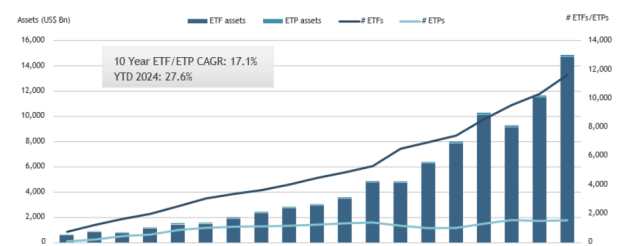|
|
|

|
|||||

|
|
An exchange-traded fund (ETF) is an investment vehicle that can hold a basket of assets including, stocks, crypto, bonds, or commodities.
Unlike other businesses, investing offers numerous ways for investors to ‘skin the proverbial cat.’ For instance, some investors prefer to trade momentum stocks, others dollar-cost average into index funds, and still others prefer value investing. Additionally, the assets investors choose to trade vary dramatically depending on the individual. In investing, there is no one-size-fits-all method. Instead, investors must choose to trade the way that best fits their personality, style, and risk appetite.
Over the past twenty years, the number of exchange-traded funds has exploded from under 1,000 two decades ago to nearly 12,000 in 2025. Meanwhile, assets under management (AUM) in ETFs have grown to approximately $15 trillion!

There is a good reason for the meteoric growth of ETFs in the 2000s. ETFs provide investors with several advantages over single stocks, including:
· Diversification & Industry Exposure: Instead of buying a basket of stocks in a particular industry group or sector, investors can gain instant diversification through ETFs.
· Accessibility: ETFs can provide investors access to markets they may otherwise be unable to trade. For instance, if an investor doesn’t have a Coinbase (COIN) or crypto account, they can instead trade the iShares Bitcoin ETF (IBIT). Or, imagine an investor who wants to own gold but does not want to buy physical gold and does not qualify for a futures account. In this example, a trader who wants to invest in gold could simply buy the SPDR Gold Shares ETF (GLD), instantly gaining hassle-free gold exposure.
· Simplicity & No Single Stock Risk: The beauty of ETFs is that they allow investors to easily and affordably gain exposure to a market.Meanwhile, because ETFs are often a basket of stocks in a particular industry, they help investors to eliminate stock-specific risk.
Like with any investment class, not all ETFS are created equally. New investors should be cognizant of ETF pitfalls and dangers, including:
· Beware of Leveraged Single-Stock ETFs: Leveraged, single-stock ETFs are the new shiny object and are all the rage on Wall Street. The number of single-stock ETFs has increased from a handful in 2022 to ~200 in 2025. The reason for the growth of individual stock ETFs is the surge in retail investors using brokerages like Robinhood (HOOD) who seek to make speculative, leveraged bets.
While leverage in itself can provide its own pitfalls for investors, leveraged single-stock ETFs can compound that risk and kill performance. Unfortunately, due to the constant resetting of ETF holdings to maintain a leverage ratio, leveraged single-stock ETFs can suffer from decay and provide feeble returns compared to the underlying stock it is trying to track. For instance, Strategy (MSTR) shares are up ~3% year-to-date.
Meanwhile, shares of the Defiance Daily Target 2x Long MSTR ETF (MSTX) are down 47.63%. For this reason, investors should avoid leveraged single-stock ETFs completely or trade them sparingly and use them only for short-term trades.
· Avoid ETFs with High Expense Ratios: The expense ratio is the annual operating cost for managing an exchange-traded fund. Often, investors inadvertently pay a higher-than-necessary expense ratio. For example, the Grayscale Bitcoin ETF Trust (GBTC) tracks Bitcoin and charges an expense ratio of 1.50%. Simultaneously, the IBIT ETF charges a 0.25% expense ratio. In other words, investors are paying six times more to trade the same asset!
· Be Cautious of ETFs that Own Private Companies: ETFs can provide investors with access to private companies that they would otherwise not be able to invest in. For instance, the Destiny Tech 100 ETF (DXYZ) holds stakes in private companies such as SpaceX. Unfortunately, ETFs struggle to accurately track private valuations because fund managers must make estimates to value assets based on incomplete data. Additionally, these ETFs tend to trade at a significant discount to the net asset value (NAV) of the private entity.
· Illiquidity: Some obscure ETFs can be highly illiquid, resulting in wide bid-ask spreads (slippage) and potentially increased risk should unfavorable news hit the tape.
Bottom Line
The massive growth in the number of ETFs shows that these versatile funds have become a staple for investors seeking diversification, simplicity, and accessibility. However, the sheer variety of ETFs means that investors must do their homework and avoid common pitfalls associated with ETFs.
Want the latest recommendations from Zacks Investment Research? Today, you can download 7 Best Stocks for the Next 30 Days. Click to get this free report
This article originally published on Zacks Investment Research (zacks.com).
| Dec-05 | |
| Dec-05 | |
| Dec-05 | |
| Dec-05 | |
| Dec-05 | |
| Dec-05 | |
| Dec-05 | |
| Dec-05 | |
| Dec-05 | |
| Dec-05 | |
| Dec-05 | |
| Dec-05 | |
| Dec-05 | |
| Dec-05 | |
| Dec-05 |
Join thousands of traders who make more informed decisions with our premium features. Real-time quotes, advanced visualizations, backtesting, and much more.
Learn more about FINVIZ*Elite